The high performance composites market is expanding steadily due to increasing demand for lightweight, durable, and high-strength materials across critical industries. Growth is being driven by rapid adoption in aerospace, automotive, energy, and industrial applications where performance optimization and fuel efficiency are key priorities. The market is benefiting from continuous innovation in resin chemistry and fiber reinforcement technologies that enhance mechanical strength, corrosion resistance, and temperature tolerance.
Rising investments in research and development are improving material cost-efficiency and scalability for mass production. The current scenario reflects strong demand from defense and aviation programs, where weight reduction and structural integrity are essential.
Future growth is expected to be supported by advancements in thermoset and thermoplastic systems, coupled with automation in composite fabrication processes Market expansion is also being fueled by government initiatives promoting sustainability and emission reduction, positioning high performance composites as preferred materials in next-generation engineering and manufacturing solutions.

| Metric | Value |
|---|---|
| High Performance Composites Market Estimated Value in (2025 E) | USD 15.3 billion |
| High Performance Composites Market Forecast Value in (2035 F) | USD 40.9 billion |
| Forecast CAGR (2025 to 2035) | 10.3% |
The market is segmented by Resin Type, Fiber Type, and Application and region. By Resin Type, the market is divided into Thermoset Resins and Thermoplastic Resins. In terms of Fiber Type, the market is classified into Carbon Fiber Composites, S-Glass Composites, Aramid Fiber Composites, and Others. Based on Application, the market is segmented into Aerospace & Defense, Automotive, Wind Turbine, Pressure Vessel, Medical, Construction, and Others. Regionally, the market is classified into North America, Latin America, Western Europe, Eastern Europe, Balkan & Baltic Countries, Russia & Belarus, Central Asia, East Asia, South Asia & Pacific, and the Middle East & Africa.
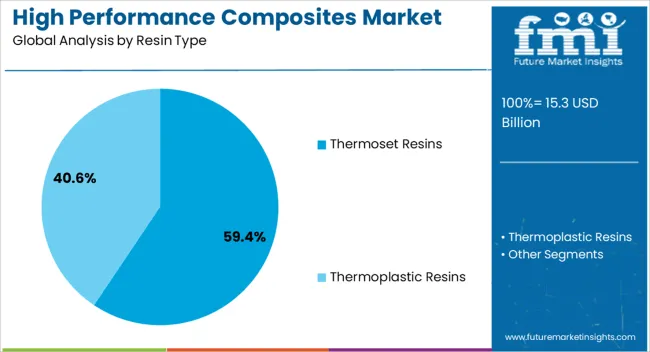
The thermoset resins segment, accounting for 59.40% of the resin type category, has emerged as the dominant material due to its superior mechanical properties, high thermal stability, and resistance to deformation under stress. Its strong adhesion capability and dimensional stability have made it indispensable in structural composite manufacturing.
Demand has been reinforced by its compatibility with various reinforcement fibers, allowing versatility across applications such as aerospace components, automotive structures, and wind turbine blades. Manufacturers have continued to optimize curing cycles and resin formulations to improve performance consistency and reduce production costs.
The segment’s reliability and proven field performance have strengthened its position within the market, and continued innovations in resin modification are expected to sustain leadership as end-use industries emphasize lightweight and durable material solutions.
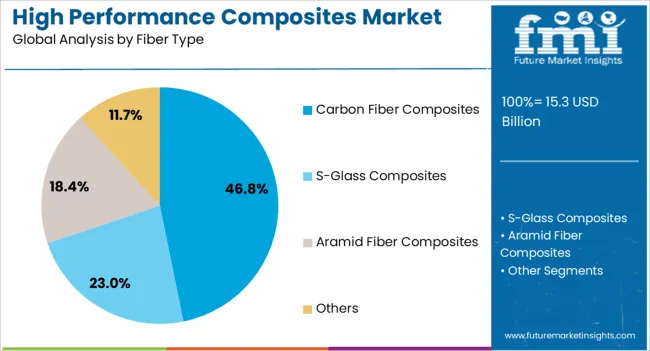
The carbon fiber composites segment, representing 46.80% of the fiber type category, leads the market owing to its exceptional strength-to-weight ratio and stiffness. Its adoption has been driven by growing utilization in high-performance sectors such as aerospace, automotive, and sports equipment manufacturing.
The segment benefits from continuous advancements in fiber production processes that have reduced costs and improved mechanical performance. Its superior fatigue resistance and corrosion protection have enhanced long-term structural reliability in demanding environments.
Strategic collaborations between fiber manufacturers and end-use industries are facilitating customized material solutions that meet specific application requirements With rising emphasis on efficiency and sustainability, the segment is expected to retain dominance through expanded use in next-generation mobility and defense platforms.
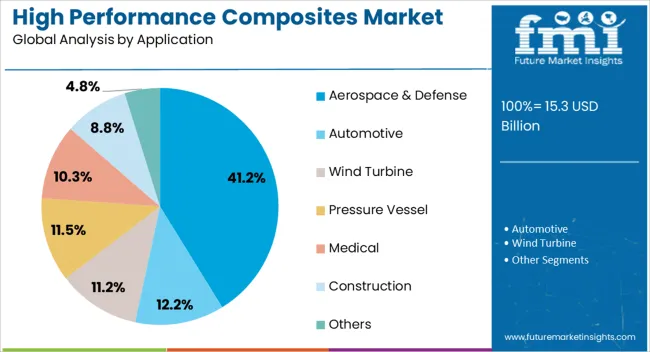
The aerospace and defense segment, holding 41.20% of the application category, remains the leading end-use sector due to the critical need for materials that deliver maximum strength at minimal weight. High performance composites are extensively used in aircraft structures, interior components, and defense-grade vehicles to enhance efficiency, maneuverability, and safety.
The segment’s growth is being supported by continuous advancements in composite manufacturing techniques, including automated fiber placement and resin transfer molding. Regulatory mandates for emission reduction and improved fuel efficiency are further accelerating composite adoption.
Investments in military modernization and commercial aircraft production programs are ensuring consistent demand The segment’s established reliability, coupled with ongoing innovations in lightweight design, is expected to maintain its market leadership and support long-term expansion across global aerospace and defense industries.
From 2020 to 2025, the high performance composites market demonstrated robust growth with a historical CAGR of 12.7%. This period saw significant demand from the aerospace, automotive, and construction industries, driven by the need for lightweight and durable materials. Technological advancements and increasing environmental concerns also contributed to the market expansion during this timeframe.
Looking ahead to the forecasted period from 2025 to 2035, the market is expected to maintain a strong growth trajectory, albeit at a slightly moderated pace with a projected CAGR of 10.3%. Factors such as continued innovation in composite materials, expanding applications in emerging sectors, and growing emphasis on sustainability are expected to sustain the market growth.
Increasing investments in infrastructure projects and rising demand for high performance composites in developing economies are anticipated to drive market expansion over the forecasted period.
| Historical CAGR from 2020 to 2025 | 12.7% |
|---|---|
| Forecast CAGR from 2025 to 2035 | 10.3% |
The provided table illustrates the top five countries in terms of revenue, with China leading the list.
China leads the high performance composites market with its robust manufacturing infrastructure and capabilities, allowing for large-scale production of composite materials at competitive prices.
The focus on innovation, investment in research and development, and growing demand across various industries contribute to its leadership in the global high performance composites market.
| Countries | Forecast CAGRs from 2025 to 2035 |
|---|---|
| The United States | 10.6% |
| South Korea | 10.8% |
| Japan | 11% |
| China | 11.1% |
| The United Kingdom | 10.9% |
The United States, being a global leader in aerospace and automotive industries, extensively uses high performance composites to reduce the weight of aircraft, spacecraft, and vehicles. This enables enhanced fuel efficiency, lower emissions, and improved overall performance, driving the demand for composites in the country.
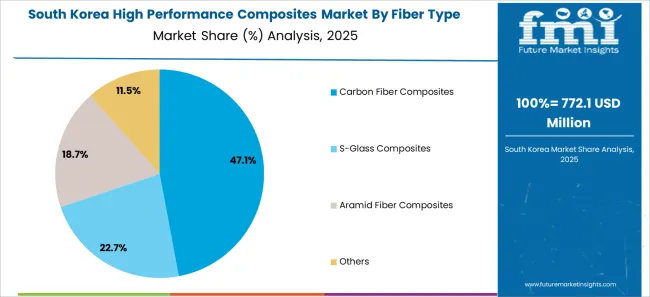
The advanced electronics and automotive sectors rely on high performance composites to develop lightweight components for consumer electronics, electric vehicles, and mobile devices. Using composites helps companies stay competitive by offering innovative and technologically advanced products to global markets.
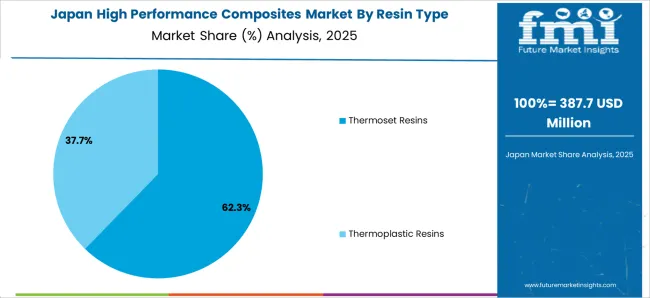
In Japan, high performance composites are widely utilized in automotive manufacturing to produce lightweight and fuel-efficient vehicles.
The strong presence in the aerospace and robotics industries further drives the demand for composites, as they offer superior strength-to-weight ratios and design flexibility.
The booming automotive industry is a major driver for adopting high performance composites as manufacturers seek to meet stringent fuel efficiency standards and consumer demands for lightweight vehicles.
The focus on infrastructure development and renewable energy projects further fuels the demand for composites in construction, wind energy, and other sectors.
The aerospace and automotive sectors are key users of high performance composites, leveraging their lightweight and durable properties to enhance aircraft and vehicle performance.
The investments in renewable energy and sustainable infrastructure projects drive the demand for composites in wind turbines, marine applications, and construction materials.
The below section shows the leading segment. Based on resin type, the thermoset resins segment registers at 10.2% CAGR by 2035. Based on fiber type, the carbon fiber composites segment is anticipated to expand at 10.1% CAGR by 2035.
Thermoset resins, such as epoxy and polyester, offer excellent properties like high strength, durability, and resistance to heat and chemicals. Carbon fiber composites are renowned for their exceptional strength-to-weight ratio, stiffness, and corrosion resistance.
| Category | CAGR from 2025 to 2035 |
|---|---|
| Thermoset Resins | 10.2% |
| Carbon Fiber Composites | 10.1% |
The thermoset resins segment is projected to achieve a CAGR of 10.2% by 2035, driven by several factors. Thermoset resins, such as epoxy and polyester, offer excellent properties such as high strength, durability, and resistance to heat and chemicals, making them suitable for various applications in aerospace, automotive, and construction industries.
The increasing demand for lightweight and high performance materials and advancements in manufacturing processes contribute to the growth of thermoset resins in the Composites market.
The carbon fiber composite segment is expected to witness a CAGR of 10.1% by 2035. Carbon fiber composites are renowned for their exceptional strength-to-weight ratio, stiffness, and corrosion resistance, making them ideal for applications requiring lightweight and high performance materials.
Industries such as aerospace, automotive, sports and leisure, and wind energy extensively use carbon fiber composites for structural components, body panels, and sporting goods.
The increasing adoption of carbon fiber composites in emerging sectors, along with ongoing research and development efforts to enhance their properties and reduce manufacturing costs, further drive the growth of this segment in the Composites market.

The landscape of the high performance composites market is characterized by a competitive environment with key players where the companies offer a wide range of high performance Composites materials and solutions tailored to various industries such as aerospace, automotive, sports, and leisure.
Numerous smaller players and niche providers specialize in specific composite formulations and applications, contributing to the diverse and dynamic nature of the market. Competition is driven by factors such as product innovation, technological advancements, and customer service. Some of the key developments are:
| Attributes | Details |
|---|---|
| Estimated Market Size in 2025 | USD 13.9 billion |
| Projected Market Valuation in 2035 | USD 36.8 billion |
| Value-based CAGR 2025 to 2035 | 10.3% |
| Forecast Period | 2025 to 2035 |
| Historical Data Available for | 2020 to 2025 |
| Market Analysis | Value in USD billion |
| Key Regions Covered | north america; latin america; western europe; eastern europe; south asia and pacific; east asia; middle east and africa |
| Key Market Segments Covered | resin type, fiber type, application, region |
| Key Countries Profiled | the united states, canada, brazil, mexico, germany, the united kingdom, france, spain, italy, russia, poland, czech republic, romania, india, bangladesh, australia, new zealand, china, japan, south korea, gcc countries, south africa, israel |
| Key Companies Profiled | toray industries inc.; solvay s.a.; hexcel corporation; sgl group-the carbon company; tpi composites; koninklijke tencate nv; owens corning corporation; basf se; teijin limited; albany international corporation |
The global high performance composites market is estimated to be valued at USD 15.3 billion in 2025.
The market size for the high performance composites market is projected to reach USD 40.9 billion by 2035.
The high performance composites market is expected to grow at a 10.3% CAGR between 2025 and 2035.
The key product types in high performance composites market are thermoset resins and thermoplastic resins.
In terms of fiber type, carbon fiber composites segment to command 46.8% share in the high performance composites market in 2025.






Our Research Products

The "Full Research Suite" delivers actionable market intel, deep dives on markets or technologies, so clients act faster, cut risk, and unlock growth.

The Leaderboard benchmarks and ranks top vendors, classifying them as Established Leaders, Leading Challengers, or Disruptors & Challengers.

Locates where complements amplify value and substitutes erode it, forecasting net impact by horizon

We deliver granular, decision-grade intel: market sizing, 5-year forecasts, pricing, adoption, usage, revenue, and operational KPIs—plus competitor tracking, regulation, and value chains—across 60 countries broadly.

Spot the shifts before they hit your P&L. We track inflection points, adoption curves, pricing moves, and ecosystem plays to show where demand is heading, why it is changing, and what to do next across high-growth markets and disruptive tech

Real-time reads of user behavior. We track shifting priorities, perceptions of today’s and next-gen services, and provider experience, then pace how fast tech moves from trial to adoption, blending buyer, consumer, and channel inputs with social signals (#WhySwitch, #UX).

Partner with our analyst team to build a custom report designed around your business priorities. From analysing market trends to assessing competitors or crafting bespoke datasets, we tailor insights to your needs.
Supplier Intelligence
Discovery & Profiling
Capacity & Footprint
Performance & Risk
Compliance & Governance
Commercial Readiness
Who Supplies Whom
Scorecards & Shortlists
Playbooks & Docs
Category Intelligence
Definition & Scope
Demand & Use Cases
Cost Drivers
Market Structure
Supply Chain Map
Trade & Policy
Operating Norms
Deliverables
Buyer Intelligence
Account Basics
Spend & Scope
Procurement Model
Vendor Requirements
Terms & Policies
Entry Strategy
Pain Points & Triggers
Outputs
Pricing Analysis
Benchmarks
Trends
Should-Cost
Indexation
Landed Cost
Commercial Terms
Deliverables
Brand Analysis
Positioning & Value Prop
Share & Presence
Customer Evidence
Go-to-Market
Digital & Reputation
Compliance & Trust
KPIs & Gaps
Outputs
Full Research Suite comprises of:
Market outlook & trends analysis
Interviews & case studies
Strategic recommendations
Vendor profiles & capabilities analysis
5-year forecasts
8 regions and 60+ country-level data splits
Market segment data splits
12 months of continuous data updates
DELIVERED AS:
PDF EXCEL ONLINE
High Performance Permanent Magnet Market Size and Share Forecast Outlook 2025 to 2035
High Performance Liquid Chromatography-Tandem Mass Spectrometry System Market Size and Share Forecast Outlook 2025 to 2035
High-performance Dual-core Processor Market Size and Share Forecast Outlook 2025 to 2035
High Performance Magnet Market Size and Share Forecast Outlook 2025 to 2035
High Performance Random Packing Market Forecast Outlook 2025 to 2035
High Performance Medical Plastic Market Forecast Outlook 2025 to 2035
High Performance Epoxy Coating Market Size and Share Forecast Outlook 2025 to 2035
High Performance Fluoropolymer Market Size and Share Forecast Outlook 2025 to 2035
High-Performance Fiber Market Size and Share Forecast Outlook 2025 to 2035
High Performance Carbon Fiber Precursor Market Size and Share Forecast Outlook 2025 to 2035
High Performance Mercury Sorbent Market Size and Share Forecast Outlook 2025 to 2035
High-performance Electric Sports Cars Market Size and Share Forecast Outlook 2025 to 2035
High-Performance Computing Market Size and Share Forecast Outlook 2025 to 2035
High Performance Polyamides Market Size and Share Forecast Outlook 2025 to 2035
High Performance Data Analytics (HPDA) Market Size and Share Forecast Outlook 2025 to 2035
High Performance Pigments Market Size and Share Forecast Outlook 2025 to 2035
High Performance Trucks Market Size and Share Forecast Outlook 2025 to 2035
High Performance Barrier Films Market Size, Growth, and Forecast 2025 to 2035
High Performance Message Infrastructure Market Size, Growth, and Forecast 2025 to 2035
High-Performance Fibers for Defense Market Report – Demand, Trends & Industry Forecast 2025 to 2035

Thank you!
You will receive an email from our Business Development Manager. Please be sure to check your SPAM/JUNK folder too.
Chat With
MaRIA